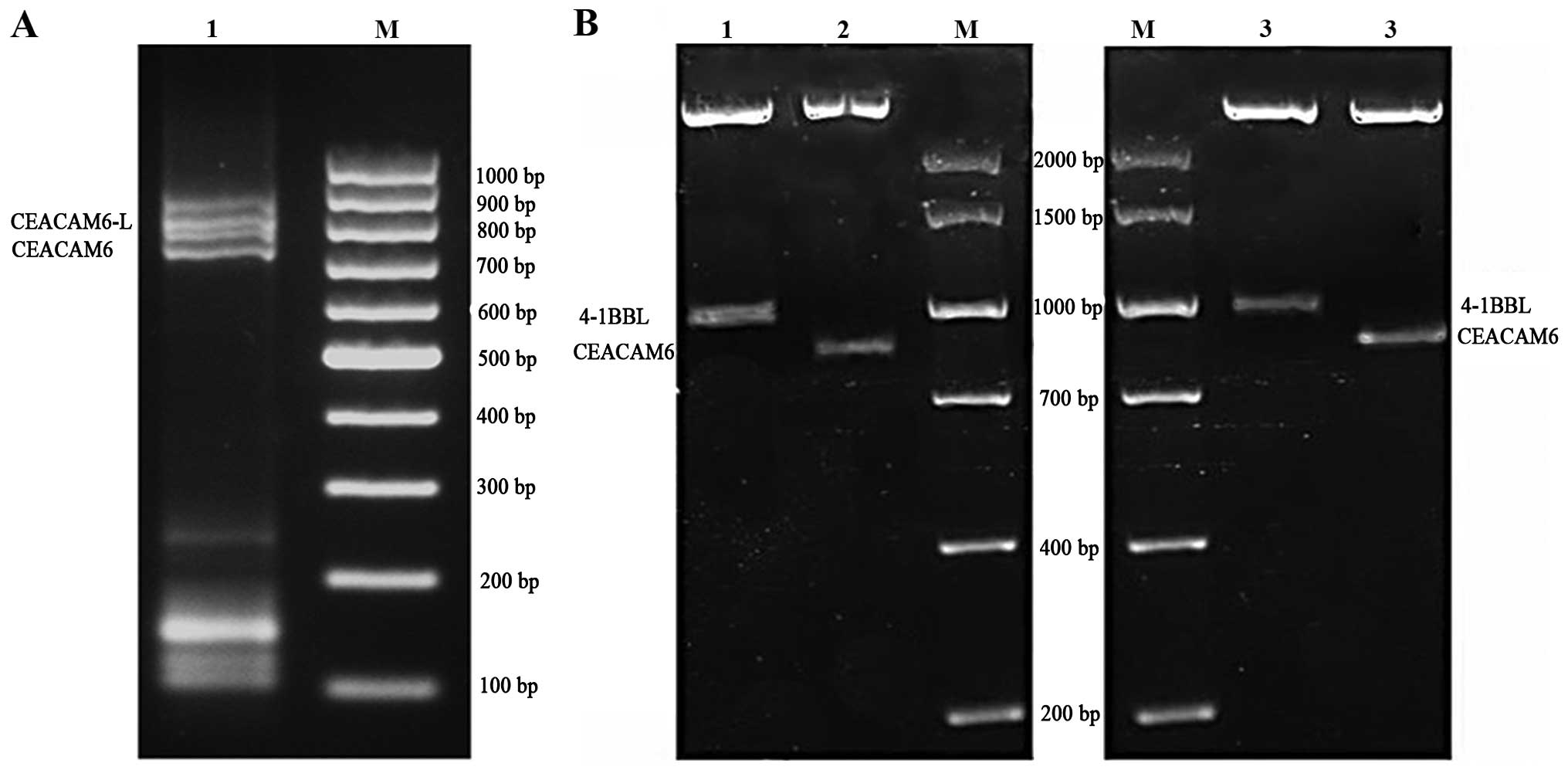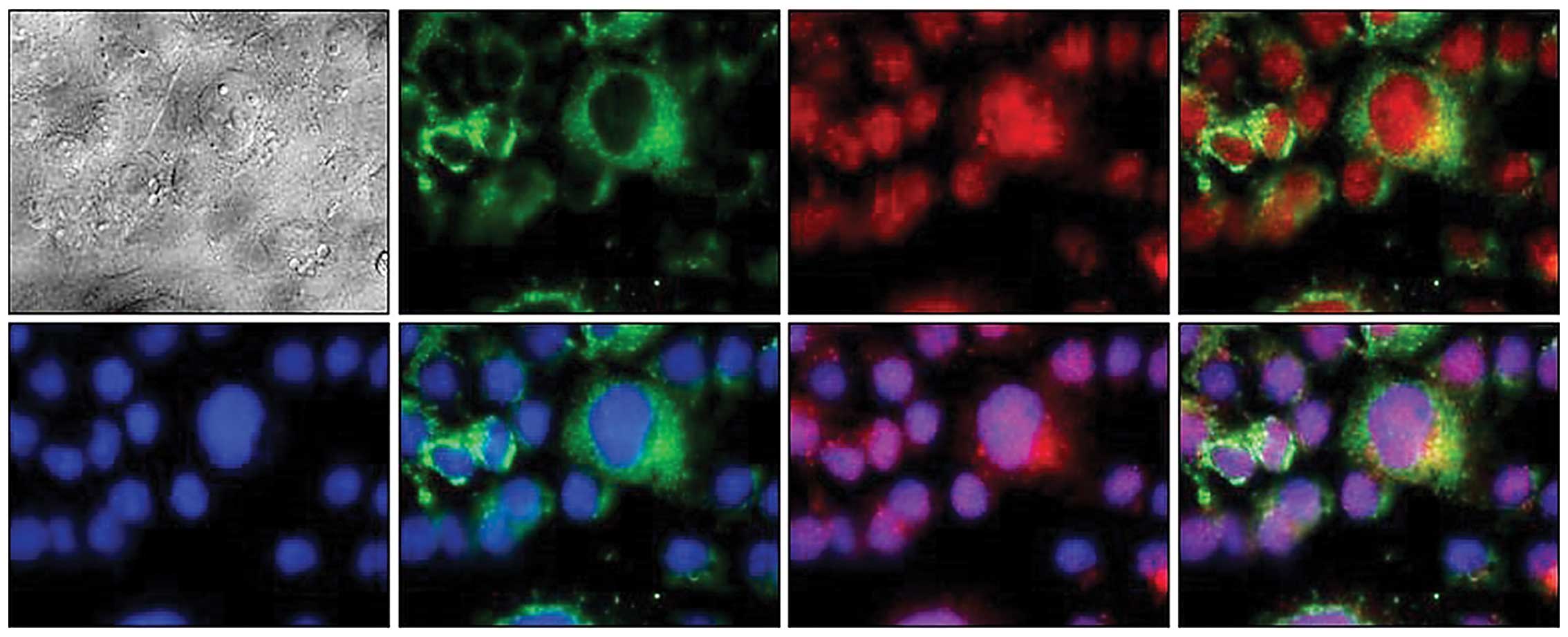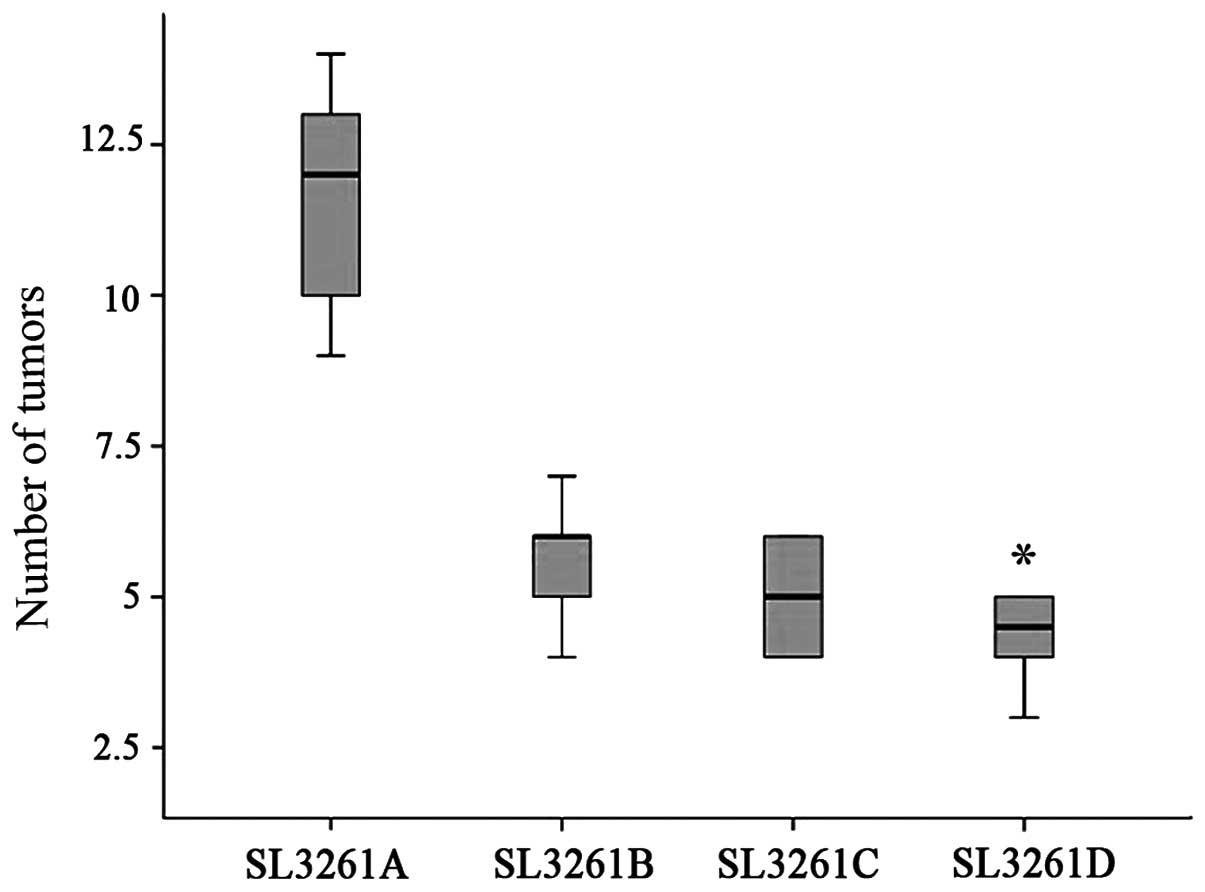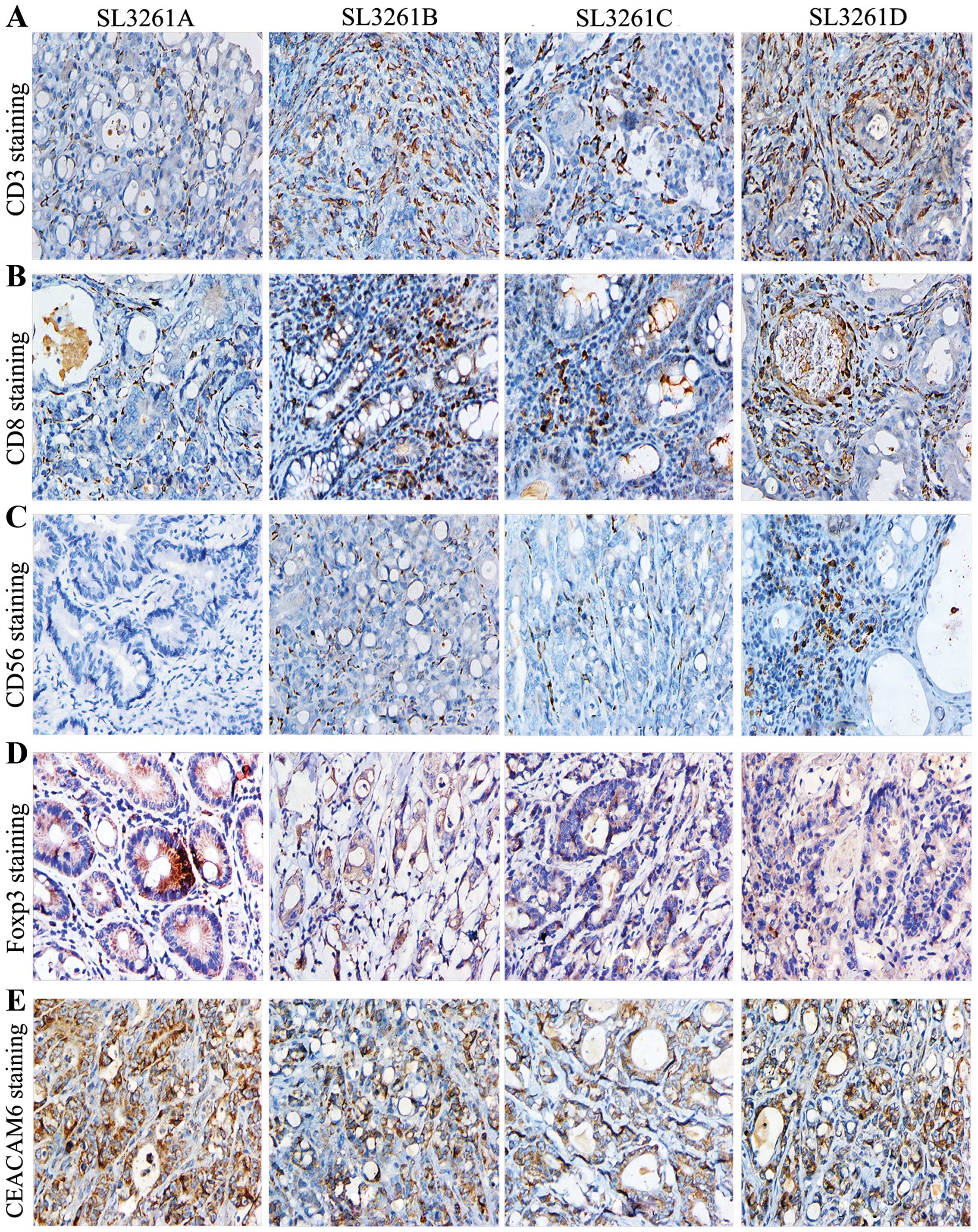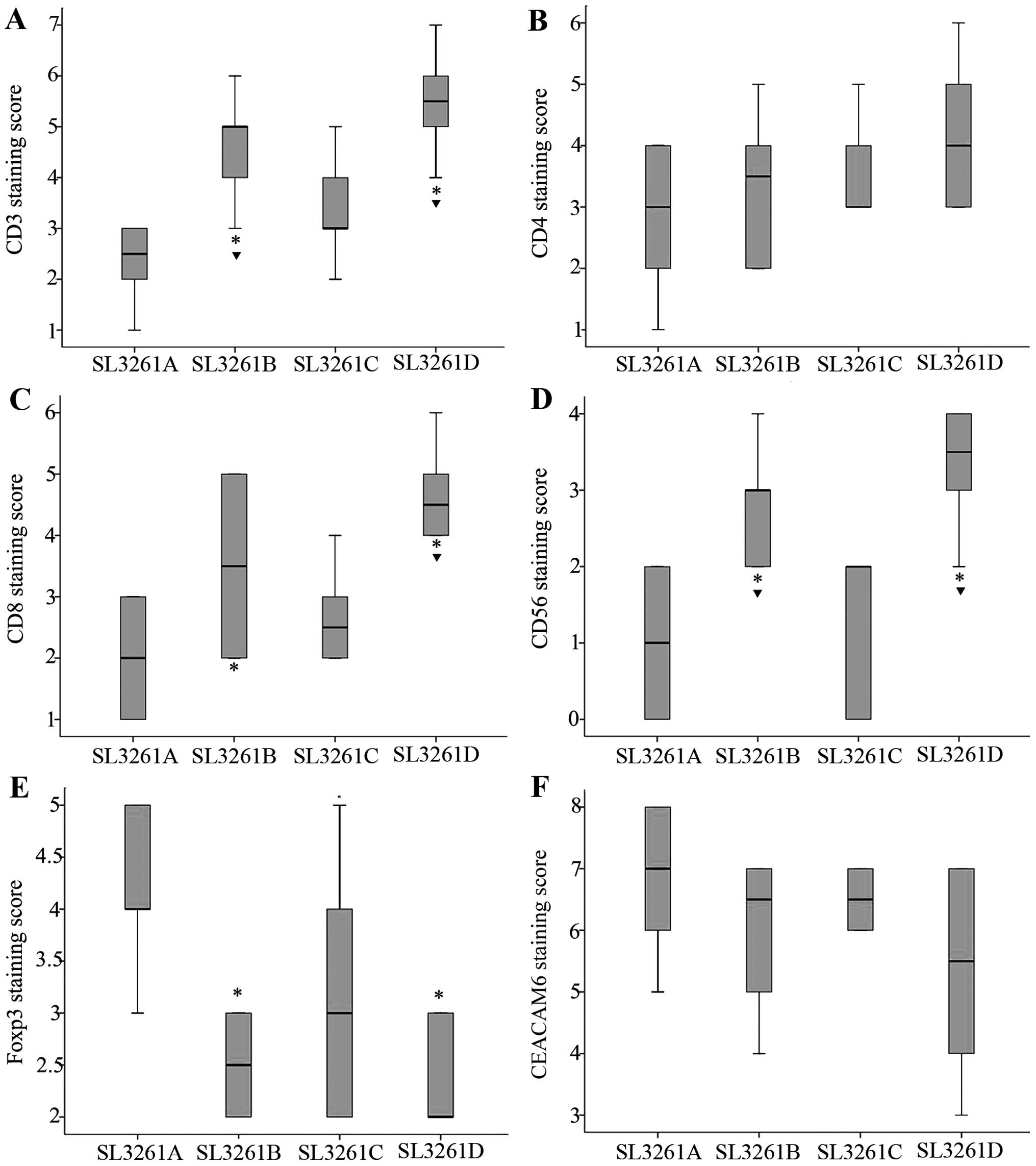Recombinant Salmonella-based CEACAM6 and 4-1BBL vaccine enhances T-cell immunity and inhibits the development of colorectal cancer in rats: In vivo effects of vaccine containing 4-1BBL and CEACAM6
- Authors:
- Published online on: April 7, 2015 https://doi.org/10.3892/or.2015.3901
- Pages: 2837-2844
Abstract
Introduction
Immunotherapy is an attractive strategy for the prevention of tumor recurrence and the control of cancer growth (1,2). Immunotherapy can induce antigen-specific T cell responses that can inhibit tumor growth. Effective activation of naïve T cells depends on TCR engagement and efficient co-stimulation (3,4). The 4-1BB ligand (L) is expressed on antigen-presenting cells (APC), and can interact with 4-1BB on activated T cells, co-stimulating T-cell cytokine production and proliferation (5–8) and prolonging T-cell survival (7,9). Therefore, 4-1BB and 4-1BBL are important regulators of T-cell immunity.
CEACAM6 (also known as CD66c or NCA-90) is a non-specific cross-reacting glycoprotein antigen that shares some antigenic determinants with CEACAM5 (also known as CD66e, which codes for the protein, CEA) (10). CEACAM6 is also expressed on granulocytes and epithelia from various organs, and has a broader expression zone in the proliferating cells of hyperplastic colonic polyps and adenomas, compared with normal mucosa (11), as well as by many human cancers (11–13). Relatively high serum levels of CEACAM6 are found in patients with lung, pancreatic, breast, colorectal and hepatocellular carcinomas. The amount of CEACAM6 does not correlate with the amount of CEACAM5 expressed (12). For all the tumors, the amount of CEACAM6 expressed was greater than that of CEACAM5 and reflected tumor histotype. CEACAM6 is a more promising target for antibody-based anti-metastatic and chemosensitizing therapy than CEACAM5 in all the solid tumors studied. Furthermore, CEACAM6 is a useful antigen to target in select subtypes of solid tumors (14).
Previously, we found that vaccination with recombinant attenuated Salmonella harboring the 4-1BBL gene efficiently enhanced T-cell immunity and inhibited the development of carcinogen-induced colorectal cancer in rats (15). In the present study, we investigated the effects of vaccination with a recombinant Salmonella-based CEACAM6 and 4-1BBL vaccine on the development of 1,2-dimethylhydrazine (DMH)-induced colorectal tumors in rats. The results indicated that this recombinant vaccine increased the number of CD3+CD8+ tumor-infiltrating lymphocyte (TIL) and CD56+ cells, decreased the number of FOXP3 TIL cells, enhanced antitumor immune responses and inhibited the development of DMH-induced colorectal cancer in rats.
Materials and methods
Animals
A total of 24 male Sprague Dawley (SD) rats, aged 6–8 weeks, were obtained from the Experimental Animal Center of Soochow university. The rats were housed in a specific-pathogen-free (SPF) facility in a 12-h light/dark cycle at 50±10% humidity and 21±2°C with free access to water and food. The body weights of individual rats were measured weekly. The experimental protocols were approved by the Ethics Committee of the First Affiliated Hospital of Soochow university. Ether was used for mouse euthanasia and anesthesia.
Construction and identification of expression plasmids
Total RNA was isolated from testis of rats and reverse transcribed into cDNA using a specific kit (Takara, Dalian, China). The primers used were: 5-CAGAGCCAAACAACAGAT (forward) and 5-CATTATTACTTATGCTGACCT (reverse) according to an open reading frame of full-length CEACAM6 (GenBank: BC078962.1). The PCR-amplified DNA was cloned into the pMDT-19 vector, which was a kind gift from Professor Cen (Soochow university), to yield pMDT-19-CEACAM6. CEACAM6 cDNA was then excised from the plasmid by restriction enzymes NheI and MluI and ligated into the pIRES (Palo Alto, CA, USA) to yield pIRES-CEACAM6. Recombinant vectors were identified and the 4-1BBL cDNA fragment was excised from the plasmid pMDT-18-4-1BBL, which was constructed as previously described (16), by restriction enzymes EagI and XbalI, blunt-ended, and ligated into the pIRES2 to yield pIRES2-4-1BBL. The plasmid pIRES2-CEACAM6-4-1BBL contained the CEACAM6 fused to the C terminus of murine 4-1BBL, thereby generating a dual-function chimeric construct. The plasmids were digested by restriction enzymes NheI, MluI, EagI and XbalI, and measured by 1% agarose gel electrophoresis. The results showed the products of RT-PCR of pIRES-CEACAM6, pIRES-4-1BBL and pIRES-CEACAM6-4-1BBL were ~801 and 930 bp, which corresponded with CEACAM6 cDNA and 4-1 BBL cDNA (Fig. 1).
Transfection of CEACAM6 and 4-1BBL
Each plasmid DNA was transfected into COS-7 cells using Lipofectamine™ 2000 reagent (Invitrogen) according to the manufacturer’s instructions. After 48 h of culture, the transfected cells were fixed with 3% paraformaldehyde in PBS for 15 min, treated with 50 mm NH4Cl for 10 min, permeabilized in 0.1% Triton X-100 for 5 min and washed with PBS. Following exposure to PBS containing 5% non-fat milk, the transfected cells were subjected to double immunostaining by polyclonal anti-CEACAM6 antibody (Abcam, Cambridge, UK) and polyclonal anti-4-1BBL antibody (Santa Cruz Biotechnology, Inc., Santa Cruz, CA, USA) in the blocking buffer, followed by incubation with Cy3 conjugated with goat anti-rabbit IgG (Biyuntian Biotechnology Research Institute, Shanghai, China) and donkey anti-goat IgG conjugated with FITC. To stain the nuclei of COS-7 cells, immunostained cells were exposed for 30 min to PBS containing Hoechst 33342. The samples were washed with PBS and examined using a confocal laser scanning microscope.
Construction and identification of attenuated Salmonella-containing plasmids
Plasmids pIRES, pIRES-4-1BBL, pIRES-CEACAM6 and pIRES-CEACAM6-4-1BBL were electrotransfected into Salmonella LB5000. After modification, the plasmids were extracted and electrotransfected into attenuated S. serovar typhimurium SL3261. The recombinant bacteria were designated as pIRES/SL3261 (SL3261 with pIRES plasmid), pIRES-4-1BBL/SL3261 (SL3261 with pIRES-4-1BBL plasmid), pIRES-CEACAM6/SL3261 (SL3261 with pIRES-CEACAM6 plasmid), and pIRES-CEACAM6-4-1BBL/SL3261 (SL3261 with pIRES-CEACAM6-4-1BBL plasmid). The bacteria were cultivated in LB-medium (antibiotics free) for 5 days and subsequently harvested. Specimens were seeded in LB plates containing kanamycin for the screening of positive clones. PCR was applied to identify plasmids extracted from the positive clones.
Establishment of rat model of colorectal tumor
Individual animals were administered subcutaneously with 20 mg/kg DMH (Sigma, St. Louis, MO, USA) weekly for 18 consecutive weeks. Eight weeks after the first DMH administration, the rats were randomized and gavaged with 2 ml PBS, PBS containing 2×109 pIRES-transformed SL3261A, pIRES-4-1BBL-transformed SL3261B, pIRES-CEACAM6-transformed SL3261C or pIRES-CEACAM6-4-1BBL-transformed SL3261D four times every two weeks as the pIRES/SL3261, pIRES-4-1BBL/SL3261, pIRES-CEACAM6/SL3261 or pIRES-CEACAM6-4-1BBL/SL3261 group. At 18 weeks after the first DMH injection, the rats were anesthetized, blood samples were collected, and the animals were sacrificed. The colons were dissected for immunohistochemical staining.
Gross and histological examination
Tissues from the entire colon (from the cecum to the anus) of individual rats were removed, washed thoroughly with ice-cold saline, cut longitudinally, and laid flat on a board. The number of tumors was counted in a blinded manner. The disease stage of the colorectal cancers were evaluated using the Duke’s stage system (17), with minor modifications. The stages were classified as: stage A, tumors only in the mucosa; stage B and C, tumors invading into muscularis propria, albeit without distant metastasis; and stage D, tumor with distant metastasis.
Immunohistochemistry and cell count analysis
Adult rat tumor specimens were immunohistochemically analyzed for their infiltration with CD3-, CD4-, CD8-, CD56-, FOXP3- and CEACAM6-positive T cells. Tissue sections were prepared from formalin-fixed, paraffin-embedded tissue. After deparaf-finization and rehydration, the slides were boiled in 10 mmol/l citrate buffer (pH 6.0) for 15 min to retrieve the antigens. The endogenous peroxidase activity was blocked by incubation with 0.6% H2O2 in methanol for 20 min. The sections were then blocked with 10% normal horse serum. Mouse monoclonal antibodies recognizing rat CD3 (Santa Cruz Biotechnology, Inc.), rabbit polyclonal antibodies recognizing rat CD4 (Santa Cruz Biotechnology, Inc.), CD8 (Santa Cruz Biotechnology, Inc.), rabbit monoclonal antibodies recognizing rat CEACAM6 (Abcam), mouse monoclonal antibodies recognizing rat CD56 (Abcam) and FOXP3 (Abcam) were applied as primary antibodies at room temperature for 2 h. The slides were incubated with a biotinylated secondary antibody (horse-anti-mouse IgG, horse-anti-rabbit IgG; Santa Cruz Biotechnology) for 30 min at room temperature and AB reagent was applied according to the manufacturer’s instructions. The antigen detection was conducted by a color reaction with 3,3′-diaminobenzidine (DAB + chromogen; DakoCytomation Corp., Carpinteria, CA, USA). The sections were counterstained with hematoxylin (AppliChem, Darmstadt, Germany) and mounted with Aquatex (Merck, Darmstadt, Germany). The number of positive cells/filed was estimated and assigned a number: 0, none; 1, 1/100 cells; 2, 1/100–1/10 cells; 3, 1/10–1/3 cells; 4, 1/3–2/3 cells; and 5, >2/3 cells. The intensity of staining was then determined as: 0, none; 1, weak; 2, intermediate; and 3, strong. The first and second scores were then added together resulting in a maximum staining score of 8 for any tissue core (18). Two independent blinded investigators (C.J. and Y.L.) performed immunohistochemical analysis and the results were strongly consistent between the two readings. The results were recorded as the mean ± standard deviation for each group.
Statistical analysis
Data were presented as the means ± SD. Discrepancies among different groups were assessed by analysis of variance (ANOVA) and the difference between two groups was assessed by the Student’s t-test, while differences in the number of TILs were investigated by using the non-parametric Wilcoxon rank-sum test. P<0.05 was considered statistically significant. Statistical analyses were performed using PASW Statistics software, version 18.0 (SPSS, Inc., Chicago, IL, USA).
Results
Expression of CEACAM6 and 4-1BBL protein in COS-7 cell and identification of recombinant attenuated Salmonella
The control, empty plasmid and recombinant gene transfection COS7 cell groups were identified by RT-PCR. Amplification products were measured by 1% agarose gel electrophoresis and recombinant gene transfection cells showed 801 and ~930-bp specific bands under UV light. The control and empty vector groups had no specificity band (data not shown). Confocal microscopic analysis showed efficient delivery of CEACAM6 and 4-1BBL antigen. As shown in Fig. 2, 4-1BBL protein is a transmembrane protein, mainly located on both sides of the cell membrane, while CEACAM6 was mainly expressed in the cytoplasm. When stained with anti-4-1BBL-FITC or anti-CEACAM6-CY3, 4-1 BBL green fluorescence protein was evident while CEACAM6 appeared red under laser confocal microscopy. The attenuated Salmonella-containing plasmids also identified by RT-PCR, i.e., pIRES-4-1BBL/SL3261 pIRES-CEACAM6/SL3261 and pIRES-CEACAM6-4-1BBL/SL3261, showed the bands corresponded with CEACAM6 cDNA and 4-1 BBL cDNA whereas the empty vector group had no specific band (data not shown).
Vaccination with the SL3261D reduces the number of colorectal tumors in rats
Following the induction of colorectal tumors, two rats from the SL3261A group had bloody stools at 18 weeks after the initial DMH treatment while the other groups did not exhibit such a characteristic. Characterization of animals indicated that a large amount of bloody ascites was found in the rats. A great number of tumor nodules varying in size were observed in the mesentery and posterior peritoneum. The number of tumors at 18 weeks after DMH treatment were 11.7±2.1 in the pIRES/SL3261 group, which was significantly higher than that in the pIRES-4-1BBL/SL3261 group of 5.7±1.2, pIRES-CEACAM6/SL3261 group of 5.0±1.4 and pIRES-CEACAM6-4-1BBL/SL3261 group of 4.3±1.4 (P<0.05) (Fig. 3). In addition, we found that most of the tumors in the pIRES/SL3261 group of rats were at an advanced stage (stage B-C, 4; stage D, 2), while most tumors in the pIRES-4-1BBL/SL3261 and pIRES-CEACAM6/SL3261 groups were at stage B-C (SL3261B: stage A, 3; stage B-C, 3; SL3261C: stage A, 1; stage B-C, 5). However, the tumors in the pIRES-CEACAM6-4-1BBL/SL3261 group of rats were at stage A (stage A, 5; stage B-C, 1) (Table I). Moreover, there was no significant difference in the rat body weights among the four groups, although slightly increased body weights were observed in the pIRES-CEACAM6-4-1BBL/SL3261-vaccinated group of rats 16 weeks after DMH application.
Detection of TIL, CD56+ and CEACAM6 cells
To determine whether TIL numbers correlated with the number and staging of colorectal tumors in rats, we observed TIL cells such as CD3, CD4, CD8, CD56, FOXP3 and CEACAM6 (Fig. 4). We found that CD3+ and CD8+, but not the total number of CD4+ T cells in the pIRES-4-1BBL/SL3261 and pIRES-CEACAM6-4-1BBL/SL3261 groups were significantly higher than that in the pIRES/SL3261 group (P<0.05) (Fig. 5A–C). Furthermore, the number of CD3+ TIL cells in pIRES-4-1BBL/SL3261 and pIRES-CEACAM6-4-1BBL/SL3261 was higher than that in the pIRES-CEACAM6/SL3261 group (P<0.05). The number of CD8+ TIL cells in pIRES-CEACAM6-4-1BBL/SL3261 were higher than that in the pIRES-CEACAM6/SL3261 group (P<0.05), while CD56+ cells in the pIRES-4-1BBL/SL3261 and pIRES-CEACAM6-4-1BBL/SL3261 groups were significantly higher than that in the pIRES/SL3261 and pIRES-CEACAM6/SL3261 groups (P<0.05). However, no significant difference was detected between the pIRES-4-1BBL/SL3261 and pIRES-CEACAM6-4-1BBL/SL3261 groups (P>0.05) (Fig. 5D). The number of Foxp3 cells in the pIRES-4-1BBL/SL3261, pIRES-CEACAM6/SL3261 and pIRES-CEACAM6-4-1BBL/SL3261 groups was significantly lower than that in the pIRES/SL3261 groups (P<0.05), albeit there were no obvious difference among these groups (P>0.05) (Fig. 5E). Notably, the cell counts of CEACAM6 were the highest in pIRES/SL3261, but the lowest in the pIRES-CEACAM6-4-1BBL/SL3261 groups, albeit there were no statistical significance among the four groups.
Discussion
The 4-1BBL is a type II surface glycoprotein of the tumor necrosis factor (TNF) superfamily, and is generally expressed in APCs, such as dendritic cells, macrophages and activated B cells (4). 4-1BBL binds to 4-1BB (also known as CD137), a member of the TNFR superfamily and enhances T-cell activation (4). Previous studies have shown that the activation of 4-1BB by agonistic monoclonal antibodies (Abs) or overexpression of 4-1BBL enhances T-cell proliferation and cytokine production, upregulates anti-apoptotic gene expression and prevents activation-induced cell death (19–21). Our previous findings have shown that recombinant attenuated Salmonella harboring the 4-1BBL gene induces high levels of 4-1BBL expression in dendritic and other immune cells (15). Vaccination with this recombinant gene enhanced T-cell immunity and inhibited the development of carcinogen-induced colorectal cancers in rats (22).
CEACAM5 and CEACAM6 are members of the carcinoembryonic antigen-related cell adhesion molecule (CEACAM) family. CEACAM5 has been recognized as a clinically relevant target for passive and active immunotherapy and has been the focus of various preclinical and clinical human studies using vaccines for the active stimulation of B- and T-cell immunity (23–25). CEACAM6 is also an important protein associated with cell adhesion and is an independent prognostic factor associated with a higher risk of colorectal cancer relapse (26). Since in all tumors, CEACAM6 expression was greater than that of CEACAM5, CEACAM6 may be an important therapeutic target to control malignancy and/or metastasis. CEACAM6 is now considered a valid clinical biomarker and promising therapeutic target in melanoma, lung, colorectal and pancreatic cancers (27). Thus, we constructed recombinant Salmonella-based CEACAM6 and 4-1BBL vaccine to examine its effect on the development of DMH-induced colorectal cancer in rats and the potential immune mechanisms involved.
A previous study indicated that abnormal morphology characterized by the accumulation of undifferentiated cells with pleiomorphic and conspicuous nucleoli in a small cluster of neighboring crypts was found at 12 weeks after DMH admini stration. Microscopic carcinomatous foci were observed at 15 weeks after DMH treatment (28). Therefore, in the present study, the vaccine administration was initiated 8 weeks after DMH treatment. We found that in the pIRES-4-1BBL/SL3261, pIRES-CEACAM6/SL3261 and pIRES-CEACAM6-4-1BBL/SL3261 groups tumor growth was suppressed as compared with the pIRES/SL3261 group (P<0.05). However, no significant difference was found in the pIRES-4-1BBL/SL3261, pIRES-CEACAM6/SL3261 and pIRES-CEACAM6-4-1BBL/SL3261 groups (P>0.05), although a slightly decreased number of colorectal tumors was observed in the pIRES-CEACAM6-4-1BBL/SL3261 group. We induced colon cancer and found that most of the tumors in the pIRES/SL3261 groups were in late stage, while early and middle stages were found in the pIRES-4-1BBL/SL3261 and pIRES-CEACAM6/SL3261 groups, whereas tumors in the pIRES-CEACAM6-4-1BBL/SL3261 group were in early stage only. Thus, the results suggest that recombinant bacteria-based 4-1BBL and CEACAM6 vaccines effectively inhibited the development of colorectal cancer.
Tumor-infiltrating lymphocytes (TILs) have been considered to reflect host immune response against malignant tumors (29). Tumor infiltration by T lymphocytes has been shown to be associated with favorable prognosis, particularly in colorectal cancers (30). On the other hand, tumor infiltration by T-lymphocyte subsets endowed with immunoregulatory or suppressive potential, e.g., CD4+ T cells expressing FoxP3 transcription factor, has been suggested to be associated with tumor progression and unfavorable prognosis (31). Thus, TIL cells in the present study indicate the immune mechanisms of recombinant vaccine-suppressing tumors.
CD3+CD8+ cells are involved in T-cell immunity against tumors (32). To induce antigen-specific CD8+ cytotoxic T lymphocytes (CTLs), peptides derived from tumor associated antigens (TAAs) should be presented on the surface of antigen-presenting cells (APCs) in the context of MHC class I molecules. Previous findings have shown that vaccination with antigen peptide connected with 4-1BBL enhances dendritic cell activation and antigen uptake and promotes CD8+ T-cell effector/memory responses (33,34). As a TAA, CEACAM6 can present on the surface of APCs and induce antigen-specific CTLs. CTL is also the main component of TIL cells. In the present study, higher counts of CD8+ TIL cells were evident in the pIRES-CEACAM6-4-1BBL/SL3261 group, suggesting that the recombinant vaccine harboring the 4-1BBL and CEACAM6 genes may induce specific immune and enhance T-cell immunity and inhibit the development of colorectal cancer in rats. As the first signal, the protein encoded by the transfected CEACAM6 gene presented on the surface of APC, whereas as the costimulatory molecule, the overexpressed 4-1BBL strengthened the second signal, both of which induced the activation of specific anti-CEACAM6 CTL.
Natural killer (NK) cells are part of the innate immune system and have diverse biological functions including the ability to recognize and kill a variety of tumor cells (35). Cytolysis is performed via the release of cytotoxic granula-containing perforin and granzyme B (GrmB) or by the induction of death receptor-mediated apoptosis. NK cells are also able to produce a broad spectrum of chemokines and cytokines. Previous findings (36) have shown that NK cells are generally absent in CRC of all stages. NK cell migration into CRC tumor tissue is obviously impaired early during tumor development by mechanisms that do not affect T-cell infiltration. In the present study, we found that the CD56+ TIL cell densities were lower in the pIRES/SL3261 group, but higher in the pIRES-4-1BBL/SL3261 and pIRES-CEACAM6-4-1BBL/SL3261 groups. Zhang et al (37) found that CD137 signaling can increase the ability of CD3-CD56+NK cells to kill cancer cells by upregulating the expression of NKG2D and LFA-1. Thus, recombinant attenuated Salmonella harboring the 4-1BBL gene can upregulate the expression of 4-1BBL and kill cancer cells by the above mechanism.
Tregs are a small subset of CD4+CD25+ T cells and are identified by their expression of FOXP3, a transcription factor critical to their differentiation and suppressive function (38). FOXP3+ cell counts have been associated with a higher likelihood of disease progression in several malignancies (39,40). Consequently, we analyzed FOXP3+ TIL cells and found they were lower in the pIRES-CEACAM6-4-1BBL/SL3261 group, but higher in the pIRES/SL3261 group. These findings suggest that a high number of Treg leads to a more suppressive tumor microenvironment. However, the recombinant Salmonella-based CEACAM6 and 4-1BBL vaccine can break this microenvironment, decrease FOXP3 and inhibit colorectal cancer in rats, although the underlying mechanism remains to be determined.
We detected the expression of CEACAM6 in each group, and found that there were no more counts of intratumoral CEACAM6 in the group in which the vaccine harbored the CEACAM6 gene. By contrast, more counts of intratumoral CEACAM6 were identified in the pIRES/SL3261 group. Given that CEACAM6 is a TAA, more tumors were identified in the pIRES/SL3261 group. Consequently, the expression of TAA-CEACAM6 was higher, but due to inhibition of the tumor microenvironment, the TAA could not be recognized by the immune system and killed. The vaccine containing the CEACAM6 gene bypassed the tumor microenvironment, while as an endogenous antigen, CEACAM6 could present on the surface of APCs more efficiently and induce the body to produce a specific antitumor immune response to inhibit tumor growth, while pIRES-CEACAM6-4-1BBL/SL3261 group had the least number of tumors and the earlier stage, presumably because of the existence of costimulatory molecule 4-1 BBL to amplify the antitumor effect.
In summary, the results indicate that recombinant CEACAM6 and 4-1BBL genes effectively delivered CEACAM6 and 4-1BBL antigen to attenuated Salmonella and the Salmonella-based vaccine efficiently inhibited the development of DMH-induced colorectal tumors in rats, accompanied by increasing of the number of CD3+CD8+ and NK TIL cells and decreasing the number of FOXP3 cells by inducing specific and non-specific immunity and breaking the suppressive tumor microenvironment. Moreover, it was technically much simpler to administer. Our findings therefore may provide a new basis for the design of immunotherapies for the intervention of colorectal cancer.
Acknowledgments
The present study was supported by the grants from the National Natural Science Foundation of China (grant no. 81172166), the Natural Science Foundation of Jiangsu Province of China (grant no. BK2008171), and the Natural Science Foundation of the Jiangsu Higher Education Institutions of China (grant no. 11KJB320016).
Abbreviations:
|
CEACAM6 |
non-specific cross-reacting antigen |
|
4-1BBL |
4-1BB ligand |
|
CTL |
cytotoxic T lymphocyte |
|
DMH |
1, 2-dimethylhydrazine |
|
FOXP3 |
forkhead/winged-helix transcription factor box P3 |
|
TIL |
tumor-infiltrating lymphocyte |
References
|
Rosenberg SA, Yang JC and Restifo NP: Cancer immunotherapy: moving beyond current vaccines. Nat Med. 10:909–915. 2004. View Article : Google Scholar : PubMed/NCBI | |
|
Vinay DS and Kwon BS: Immunotherapy of cancer with 4-1BB. Mol Cancer Ther. 11:1062–1070. 2012. View Article : Google Scholar : PubMed/NCBI | |
|
Hodge JW, Greiner JW, Tsang KY, Sabzevari H, Kudo-Saito C, Grosenbach DW, Gulley JL, Arlen PM, Marshall JL, Panicali D, et al: Costimulatory molecules as adjuvants for immunotherapy. Front Biosci. 11:788–803. 2006. View Article : Google Scholar | |
|
Cheuk AT, Mufti GJ and Guinn BA: Role of 4-1BB: 4-1BB ligand in cancer immunotherapy. Cancer Gene Ther. 11:215–226. 2004. View Article : Google Scholar | |
|
Laderach D, Movassagh M, Johnson A, Mittler RS and Galy A: 4-1BB co-stimulation enhances human CD8+ T cell priming by augmenting the proliferation and survival of effector CD8+ T cells. Int Immunol. 14:1155–1167. 2002. View Article : Google Scholar : PubMed/NCBI | |
|
Shuford WW, Klussman K, Tritchler DD, Loo DT, Chalupny J, Siadak AW, Brown TJ, Emswiler J, Raecho H, Larsen CP, et al: 4-1BB costimulatory signals preferentially induce CD8+ T cell proliferation and lead to the amplification in vivo of cytotoxic T cell responses. J Exp Med. 186:47–55. 1997. View Article : Google Scholar : PubMed/NCBI | |
|
Cannons JL, Lau P, Ghumman B, DeBenedette MA, Yagita H, Okumura K and Watts TH: 4-1BB ligand induces cell division, sustains survival, and enhances effector function of CD4 and CD8 T cells with similar efficacy. J Immunol. 167:1313–1324. 2001. View Article : Google Scholar : PubMed/NCBI | |
|
Cooper D, Bansal-Pakala P and Croft M: 4-1BB (CD137) controls the clonal expansion and survival of CD8 T cells in vivo but does not contribute to the development of cytotoxicity. Eur J Immunol. 32:521–529. 2002. View Article : Google Scholar : PubMed/NCBI | |
|
Lee HW, Park SJ, Choi BK, Kim HH, Nam KO and Kwon BS: 4-1BB promotes the survival of CD8+ T lymphocytes by increasing expression of Bcl-xL and Bfl-1. J Immunol. 169:4882–4888. 2002. View Article : Google Scholar : PubMed/NCBI | |
|
Kuroki M, Matsuo Y, Kinugasa T and Matsuoka Y: Three different NCA species, CGM6/CD67, NCA-95, and NCA-90 are comprised in the major 90 to 100 kDa band of granulocyte NCA detectable upon SDS-polyacrylamide gel electrophoresis. Biochem Biophys Res Comm. 182:501–506. 1992. View Article : Google Scholar | |
|
Scholzel S, Zimmermann W, Schwarzkopf G, Grunert F, Rogaczewski B and Thompson J: Carcinoembryonic antigen family members CEACAM6 and CEACAM7 are differentially expressed in normal tissues and oppositely deregulated in hyperplastic colorectal polyps and early adenomas. Am J Pathol. 157:1051–1052. 2000. | |
|
Kuroki M, Matsushita H, Matsumoto H, Hirose Y, Senba T and Yamamoto T: Nonspecific cross-reacting antigen 50/90 (NCA-50/90) as a new tumor marker. Anticancer Res. 19:5599–5606. 1999. | |
|
Hinoda Y, Saito T, Takahashi H, Itoh F, Adachi M and Imai K: Induction of nonspecific cross-reacting antigen mRNA by interferongamma and anti-fibronectin receptor antibody in colon cancer cells. J Gastroenterol. 32:200–205. 1997. View Article : Google Scholar : PubMed/NCBI | |
|
Blumenthal RD, Leon E, Hansen HJ and Goldenberg DM: Expression patterns of CEACAM5 and CEACAM6 in primary and metastatic cancers. BMC Cancer. 7:22007. View Article : Google Scholar : PubMed/NCBI | |
|
Ye JX, Zhang YT, Zhang XG, Ren DM and Chen WC: Recombinant attenuated Salmonella harboring 4-1BB ligand gene enhances cellular immunity. Vaccine. 27:1717–1723. 2009. View Article : Google Scholar : PubMed/NCBI | |
|
Tan JX, Chen WC, Zhang XG and Zhang GB: The change of immunoactivity of dendritic cells induced by recombinant rat 4-1BBL. Xi Bao Yu Fen Zi Mian Yi Xue Za Zhi. 24:764–767. 2008.In Chinese. PubMed/NCBI | |
|
Kyriakos M: The President’s cancer, the Dukes classification, and confusion. Arch Pathol Lab Med. 109:1063–1066. 1985.PubMed/NCBI | |
|
Kawai H, Ishii A, Washiya K, Konno T, Kon H, Yamaya C, Ono I, Minamiya Y and Ogawa J: Estrogen receptor alpha and beta are prognostic factors in non-small cell lung cancer. Clin Cancer Res. 11:5084–5089. 2005. View Article : Google Scholar : PubMed/NCBI | |
|
Watts TH: TNF/TNFR family members in costimulation of T cell responses. Annu Rev Immunol. 23:23–68. 2005. View Article : Google Scholar : PubMed/NCBI | |
|
Croft M: Co-stimulatory members of the TNFR family: keys to effective T-cell immunity? Nat Rev Immunol. 3:609–620. 2003. View Article : Google Scholar : PubMed/NCBI | |
|
Lim HY, Kim KK, Zhou FC, Yoon JW, Hill JM and Kwon BS: 4-1BB-like molecule is expressed in islet-infiltrating mono-nuclear cells and in the gray matter of the brain. Cell Biol Int. 26:271–278. 2002. View Article : Google Scholar | |
|
Ye J, Li L, Zhang Y, Zhang X, Ren D and Chen W: Recombinant salmonella-based 4-1BBL vaccine enhances T cell immunity and inhibits the development of colorectal cancer in rats: in vivo effects of vaccine containing 4-1BBL. J Biomed Sci. 20:82013. View Article : Google Scholar : PubMed/NCBI | |
|
Hou Y, Kavanagh B and Fong L: Distinct CD8+ T cell repertoires primed with agonist and native peptides derived from a tumor-associated antigen. J Immunol. 180:1526–1534. 2008. View Article : Google Scholar : PubMed/NCBI | |
|
Loisel-Meyer S, Felizardo T, Mariotti J, Mossoba ME, Foley JE, Kammerer R, Mizue N, Keefe R, McCart JA and Zimmermann W: Potent induction of B- and T-cell immunity against human carcinoembryonic antigen-expressing tumors in human carcinoembryonic antigen transgenic mice mediated by direct lentivector injection. Mol Cancer Ther. 8:692–702. 2009. View Article : Google Scholar : PubMed/NCBI | |
|
Hörig H, Medina FA, Conkright WA and Kaufman HL: Strategies for cancer therapy using carcinoembryonic antigen vaccines. Expert Rev Mol Med. 2:1–24. 2000. | |
|
Jantscheff P, Terracciano L, Lowy A, Glatz-Krieger K, Grunert F, Micheel B, Brümmer J, Laffer U, Metzger U, Herrmann R, Rochlitz C, et al: Expression of CEACAM6 in resectable colorectal cancer: a factor of independent prognostic significance. J Clin Oncol. 21:3638–3846. 2003. View Article : Google Scholar : PubMed/NCBI | |
|
Beauchemin N and Arabzadeh A: Carcinoembryonic antigen-related cell adhesion molecules (CEACAMs) in cancer progression and metastasis. Cancer Metastasis Rev. 32:643–671. 2013. View Article : Google Scholar : PubMed/NCBI | |
|
Maskens AP: Histogenesis and growth pattern of 1, 2-dimethylhydrazine-induced rat colon adenocarcinoma. Cancer Res. 36:1585–1592. 1976.PubMed/NCBI | |
|
Takagi S, Chen K, Schwarz R, Iwatsuki S, Herberman RB and Whiteside TL: Functional and phenotypic analysis of tumor-infiltrating lymphocytes isolated from human primary and metastatic liver tumors and cultured in recombinant interleukin-2. Cancer. 63:102–111. 1989. View Article : Google Scholar : PubMed/NCBI | |
|
Galon J, Costes A, Sanchez-Cabo F, Kirilovsky A, Mlecnik B and Lagorce-Pages C: Type, density, and location of immune cells within human colorectal tumors predict clinical outcome. Science. 313:1960–1964. 2006. View Article : Google Scholar : PubMed/NCBI | |
|
Curiel TJ: Regulatory T cells and treatment of cancer. Curr Opin Immunol. 20:241–246. 2008. View Article : Google Scholar : PubMed/NCBI | |
|
Schiavon V, Roth P, Bolton WE, Farcet JP, Bensussan A and Boumsell L: Lymphocytes subsets in normal individuals: analysis by four color immunofluorescence and flow cytometry on whole blood. Tissue Antigens. 48:312–318. 1996. View Article : Google Scholar : PubMed/NCBI | |
|
Sharma RK, Elpek KG, Yolcu ES, Schabowsky RH, Zhao H, Bandura-Morgan L and Shirwan H: Costimulation as a platform for the development of vaccines: a peptide-based vaccine containing a novel form of 4-1BB ligand eradicates established tumors. Cancer Res. 69:4319–4326. 2009. View Article : Google Scholar : PubMed/NCBI | |
|
Sharma RK, Schabowsky RH, Srivastava AK, Elpek KG, Madireddi S, Zhao H, Zhong Z, Miller RW, Macleod KJ, Yolcu ES, et al: 4-1BB ligand as an effective multifunctional immunomodulator and antigen delivery vehicle for the development of therapeutic cancer vaccines. Cancer Res. 70:3945–3954. 2010. View Article : Google Scholar : PubMed/NCBI | |
|
Walzer T, Jaeger S, Chaix J and Vivier E: Natural killer cells: from CD3−NKp46+ to post-genomics meta-analyses. Curr Opin Immunol. 19:365–372. 2007. View Article : Google Scholar : PubMed/NCBI | |
|
Halama N, Braun M, Kahlert C, Spille A, Quack C, Rahbari N, Koch M, Weitz J, Kloor M, Zoernig I, Schirmacher P, et al: Natural killer cells are scarce in colorectal carcinoma tissue despite high levels of chemokines and cytokines. Clin Cancer Res. 17:678–689. 2011. View Article : Google Scholar : PubMed/NCBI | |
|
Zhang Y, Ju S and Shu Y: Research on the effects of CD137 signaling on the function of CD3-CD56+NK cells. J Nanjing Medical University. 23:10–14. 2009. View Article : Google Scholar | |
|
Hori S, Nomura T and Sakaguchi S: Control of regulatory T cell development by the transcription factor Foxp3. Science. 299:1057–1061. 2003. View Article : Google Scholar : PubMed/NCBI | |
|
Hiraoka N, Onozato K, Kosuge T and Hirohashi S: Prevalence of FOXP3+ regulatory T cells increases during the progression of pancreatic ductal adenocarcinoma and its premalignant lesions. Clin Cancer Res. 12:5423–5434. 2006. View Article : Google Scholar : PubMed/NCBI | |
|
Kobayashi N, Hiraoka N, Yamagami W, Ojima H, Kanai Y and Kosuge T: FOXP3+ regulatory T cells affect the development and progression of hepatocarcinogenesis. Clin Cancer Res. 13:902–911. 2007. View Article : Google Scholar : PubMed/NCBI |



